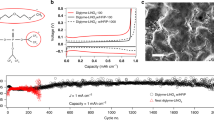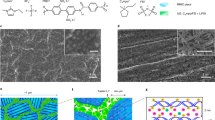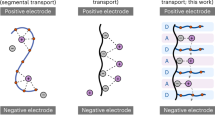Abstract
Polymer electrolytes consist of salts dissolved in polymers (for example, polyethylene oxide, PEO), and represent a unique class of solid coordination compounds. They have potential applications in a diverse range of all-solid-state devices, such as rechargeable lithium batteries, flexible electrochromic displays and smart windows1,2,3,4,5. For 30 years, attention was focused on amorphous polymer electrolytes in the belief that crystalline polymer:salt complexes were insulators. This view has been overturned recently by demonstrating ionic conductivity in the crystalline complexes PEO6:LiXF6 (X = P, As, Sb); however, the conductivities were relatively low6,7. Here we demonstrate an increase of 1.5 orders of magnitude in the conductivity of these materials by replacing a small proportion of the XF6- anions in the crystal structure with isovalent N(SO2CF3)2- ions. We suggest that the larger and more irregularly shaped anions disrupt the potential around the Li+ ions, thus enhancing the ionic conductivity in a manner somewhat analogous to the AgBr1-xIx ionic conductors8. The demonstration that doping strategies can enhance the conductivity of crystalline polymer electrolytes represents a significant advance towards the technological exploitation of such materials.
This is a preview of subscription content, access via your institution
Access options
Subscribe to this journal
Receive 51 print issues and online access
$199.00 per year
only $3.90 per issue
Buy this article
- Purchase on Springer Link
- Instant access to full article PDF
Prices may be subject to local taxes which are calculated during checkout




Similar content being viewed by others
References
Scrosati, B. (ed.) Applications of Electroactive Polymers (Chapman & Hall, London, 1993)
Bruce, P. G. Solid State Electrochemistry (Cambridge Univ. Press, Cambridge, 1995)
Gray, F. M. Polymer Electrolytes (RSC Materials Monographs, The Royal Society of Chemistry, Cambridge, 1997)
Tarascon, J.-M. & Armand, M. Issues and challenges facing rechargeable lithium batteries. Nature 414, 359–367 (2001)
Barnes, A. et al. Towards a ‘smart window’ for microwave applications. Smart Mater. Struct. 7, 752–758 (1998)
Gadjourova, Z., Andreev, Y. G., Tunstall, D. P. & Bruce, P. G. Ionic conductivity in crystalline polymer electrolytes. Nature 412, 520–523 (2001)
Stoeva, Z., Martin-Litas, I., Staunton, E., Andreev, Y. G. & Bruce, P. G. Ionic conductivity in the crystalline polymer electrolytes PEO6:LiXF6, X = P, As, Sb. J. Am. Chem. Soc. 125, 4619–4626 (2003)
Shahi, K. & Wagner, J. B. Jr. Fast ion transport in silver halide solid solutions and multiphase mixtures. Appl. Phys. Lett. 37, 757–759 (1980)
Ratner, M. A. in Polymer Electrolytes Reviews – 1 (eds MacCallum, J. R. & Vincent, C. A.) 173–236 (Elsevier Applied Science, London, 1987)
Berthier, C. et al. Microscopic investigation of ionic conductivity in alkali metal salts – poly(ethylene oxide) adducts. Solid State Ionics 11, 91–95 (1983)
Ratner, M. A. & Shriver, D. F. Ion-transport in solvent-free polymers. Chem. Rev. 88, 109–124 (1988)
Angell, C. A., Liu, C. & Sanchez, E. Rubbery solid electrolytes with dominant cationic transport and high ambient conductivity. Nature 362, 137–139 (1993)
Gadjourova, Z., Martin y Marero, D., Andersen, K. H., Andreev, Y. G. & Bruce, P. G. Structures of the polymer electrolyte complexes PEO6:LiXF6 (X = P,Sb), determined from neutron powder diffraction data. Chem. Mater. 13, 1282–1285 (2001)
Sylla, S., Sanchez, J.-Y. & Armand, M. Electrochemical study of linear and crosslinked POE-based polymer electrolytes. Electrochim. Acta 37, 1699–1701 (1992)
MacFarlane, D. R., Huang, J. H. & Forsyth, M. Lithium-doped plastic crystal electrolytes exhibiting fast ion conduction for secondary batteries. Nature 402, 792–794 (1999)
Forsyth, M., Huang, J. & MacFarlane, D. R. Lithium doped N-methyl-N-ethylpyrrolidinium bis(trifluoromethanesulfonyl) amide fast-ion conducting plastic crystals. J. Mater. Chem. 10, 2259–2265 (2000)
Acknowledgements
P.G.B. is indebted to The Royal Society, the EU and the EPSRC for financial support.
Author information
Authors and Affiliations
Corresponding author
Ethics declarations
Competing interests
The authors declare that they have no competing financial interests.
Rights and permissions
About this article
Cite this article
Christie, A., Lilley, S., Staunton, E. et al. Increasing the conductivity of crystalline polymer electrolytes. Nature 433, 50–53 (2005). https://doi.org/10.1038/nature03186
Received:
Accepted:
Issue Date:
DOI: https://doi.org/10.1038/nature03186
This article is cited by
-
Self-assembled hydrated copper coordination compounds as ionic conductors for room temperature solid-state batteries
Nature Communications (2024)
-
Lithium polymer electrolytes for novel batteries application: the review perspective
Applied Physics A (2023)
-
Tuning the electron transport behavior at Li/LATP interface for enhanced cyclability of solid-state Li batteries
Nano Research (2023)
-
Dynamics of a driven damped particle in the presence of a magnetic field: Asymmetric splitting of the output signal
Pramana (2022)
-
A novel solid-state poly(urethane-b-siloxane) block copolymer-based electrolyte with flexibility and high ion transference number for lithium metal battery
Journal of Materials Science (2022)
Comments
By submitting a comment you agree to abide by our Terms and Community Guidelines. If you find something abusive or that does not comply with our terms or guidelines please flag it as inappropriate.



